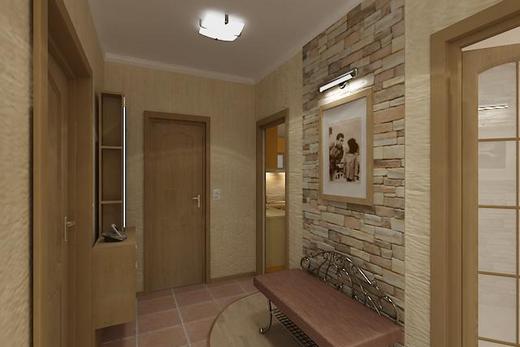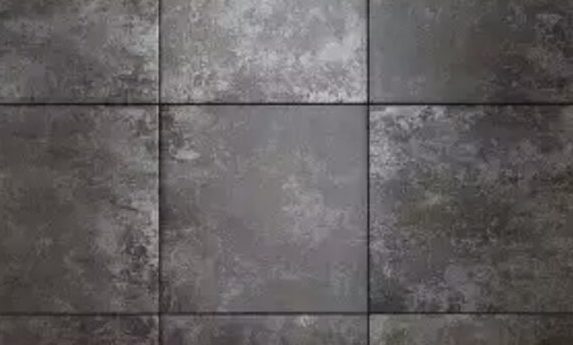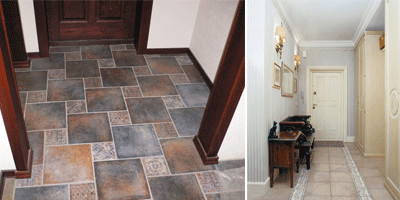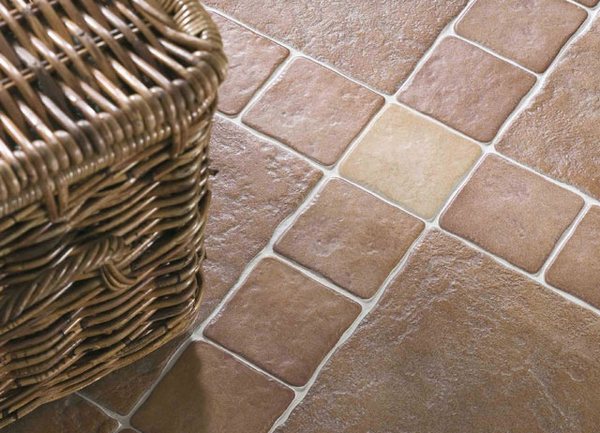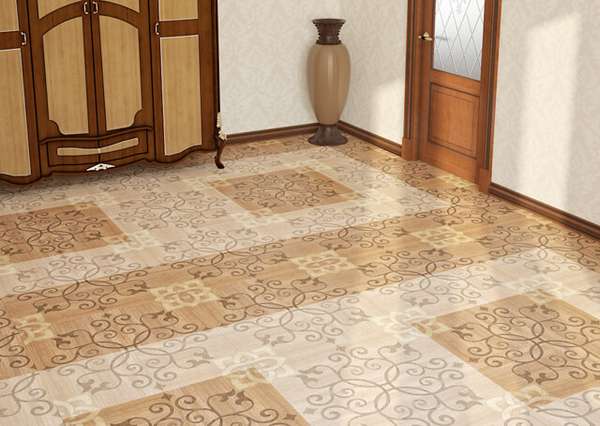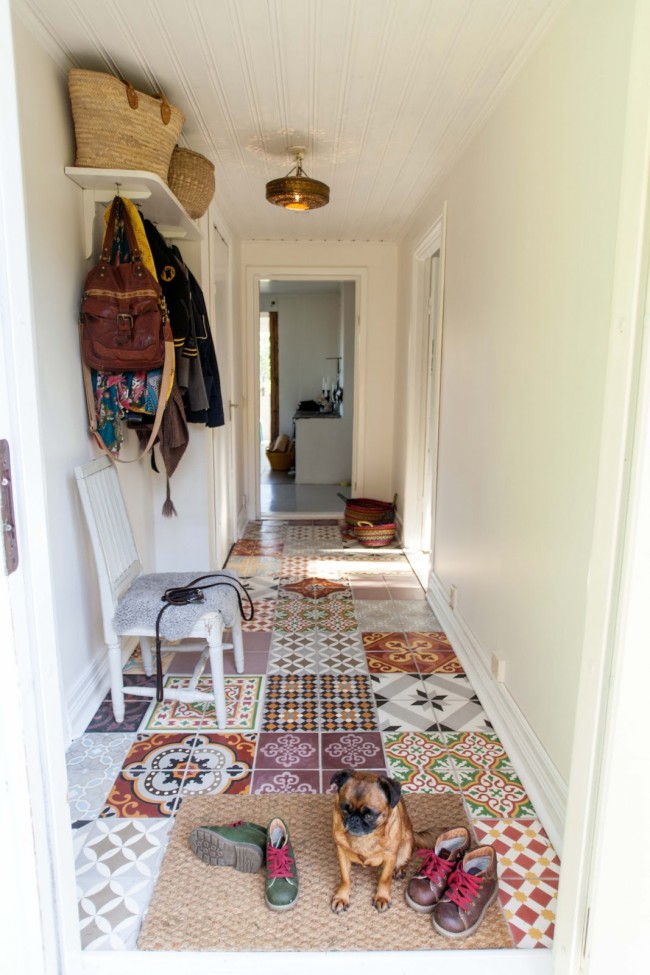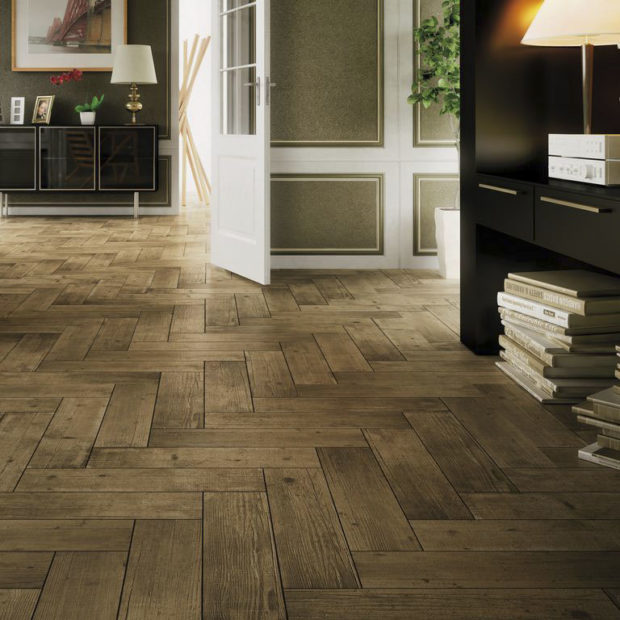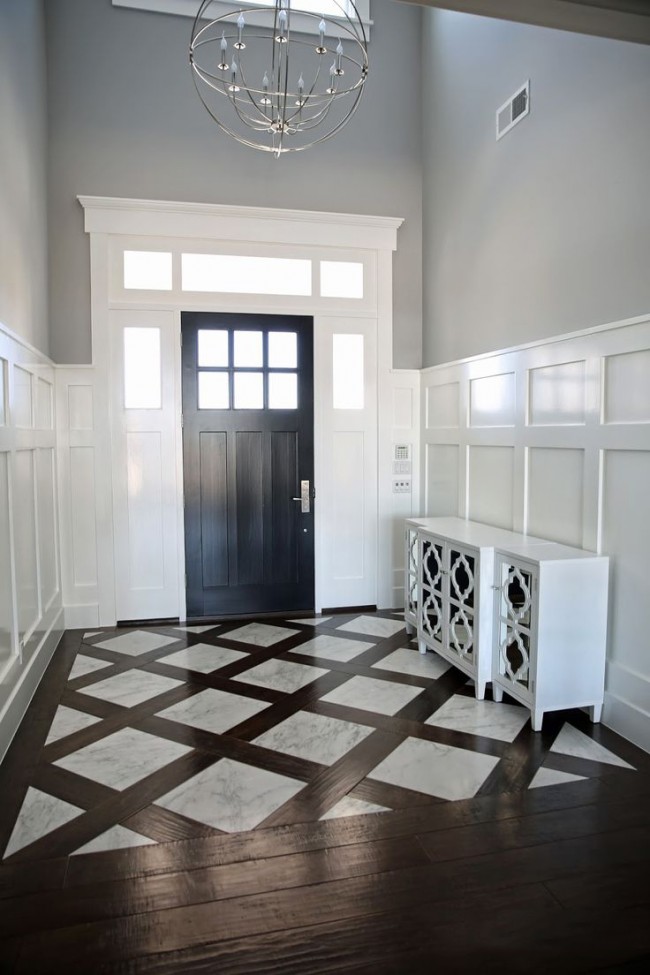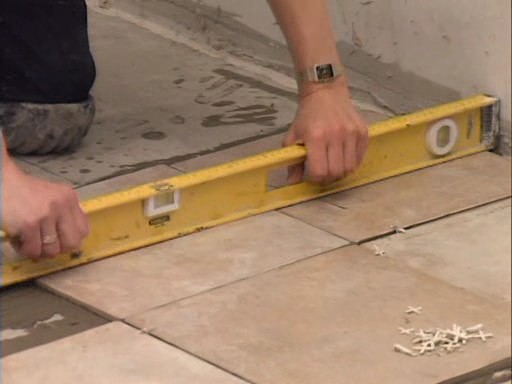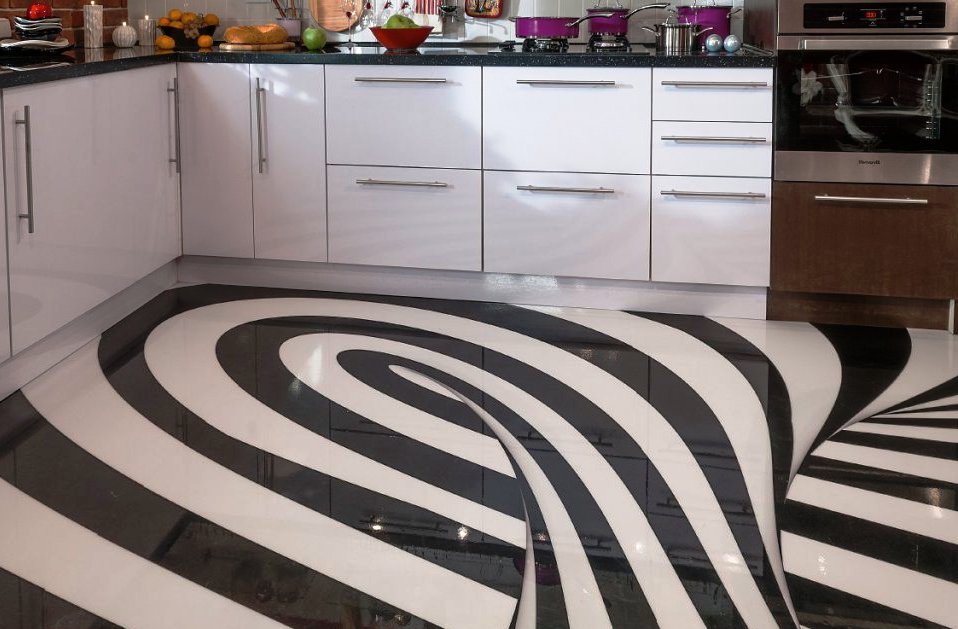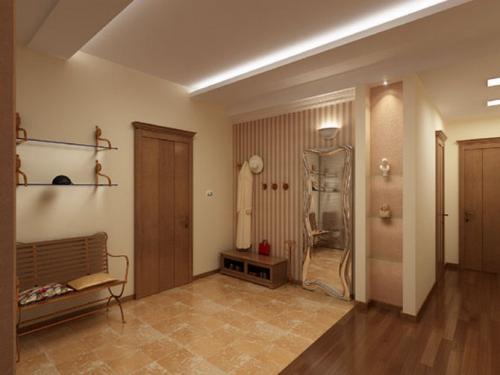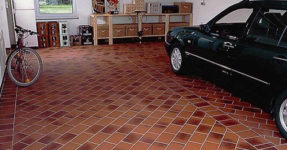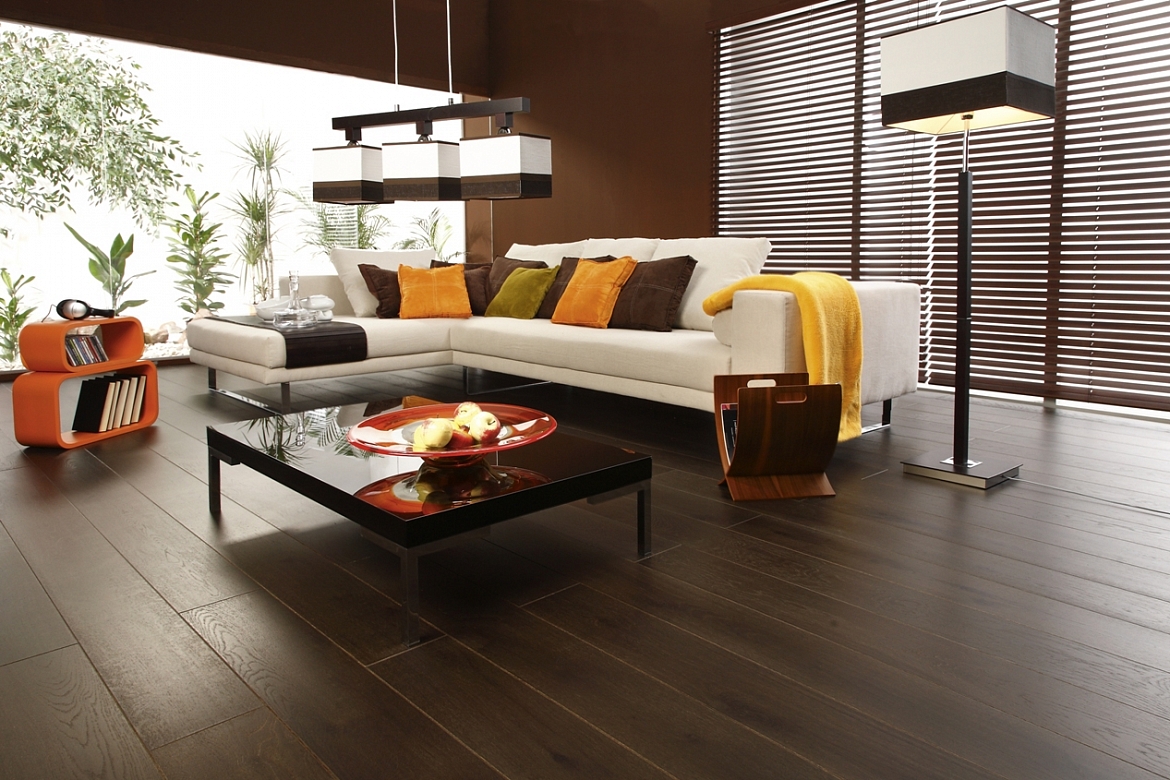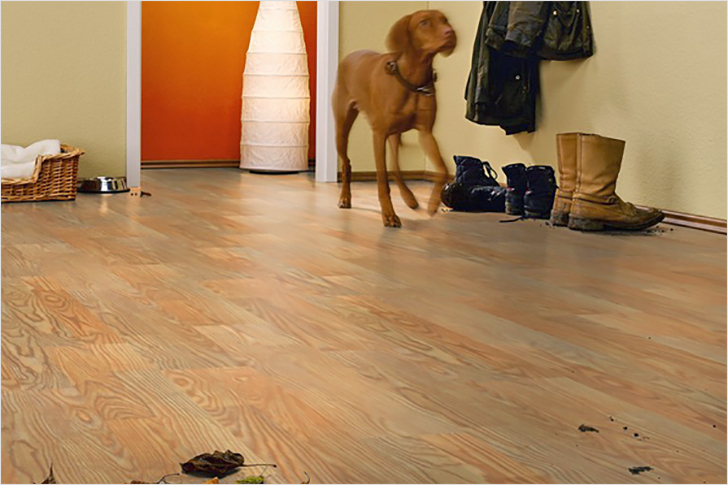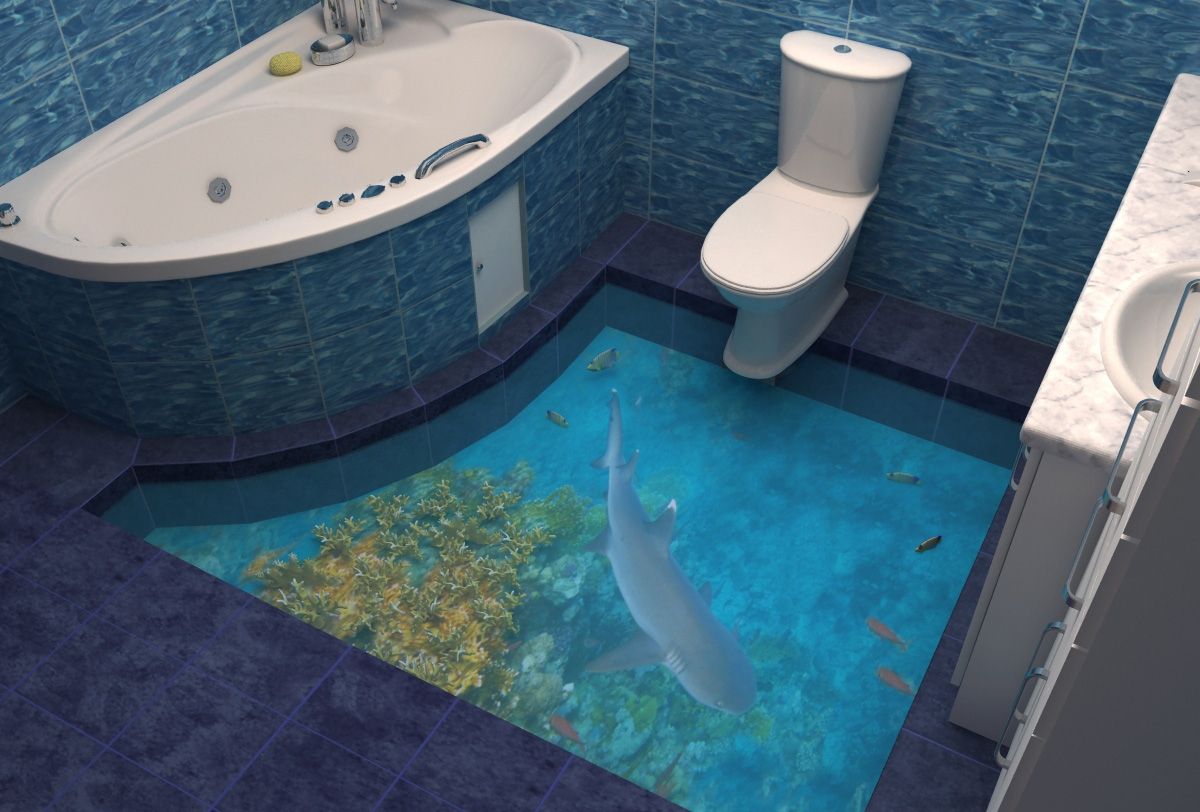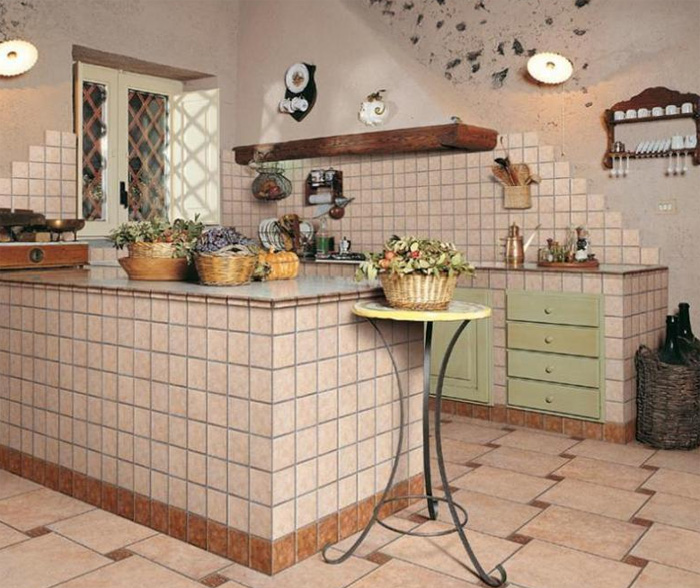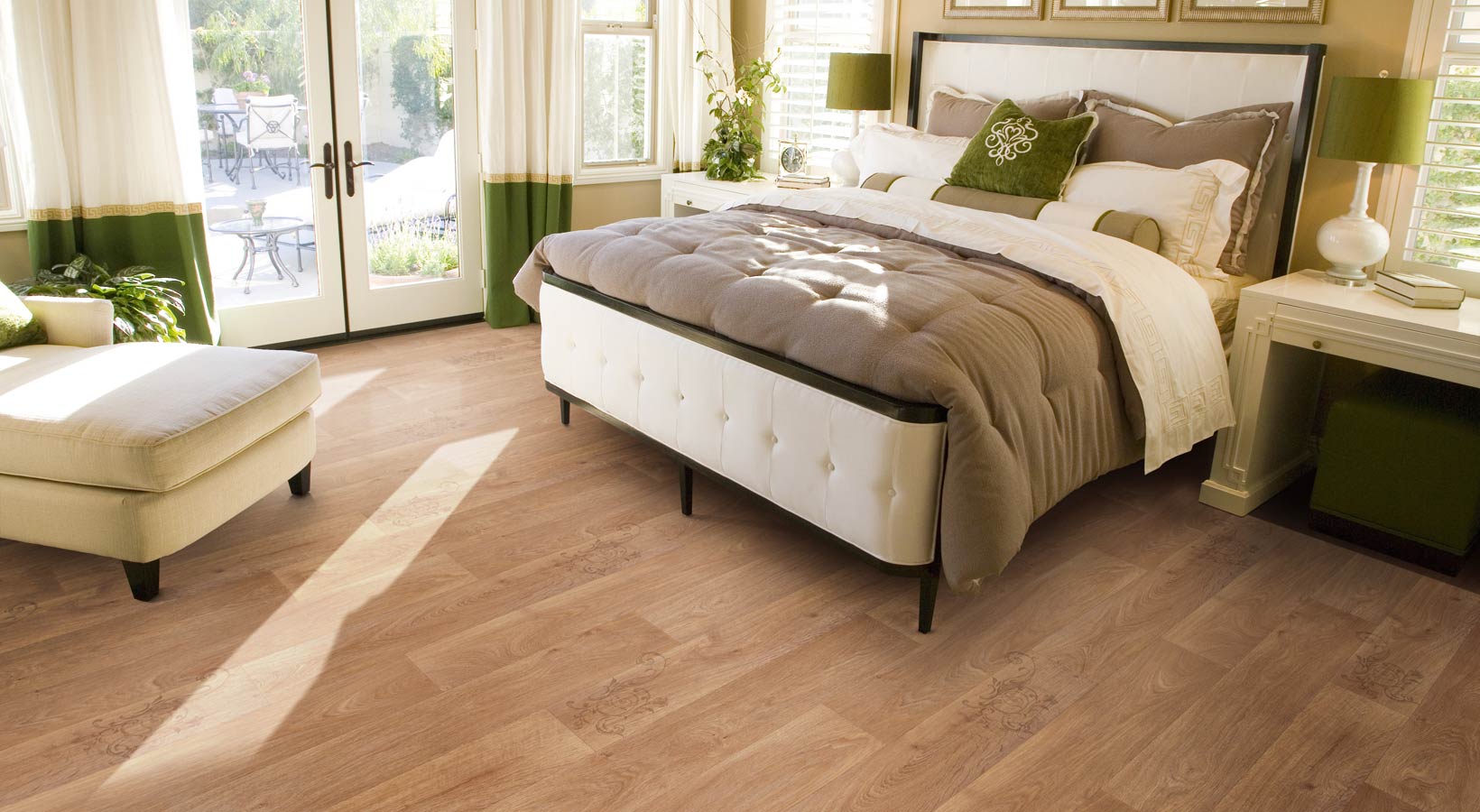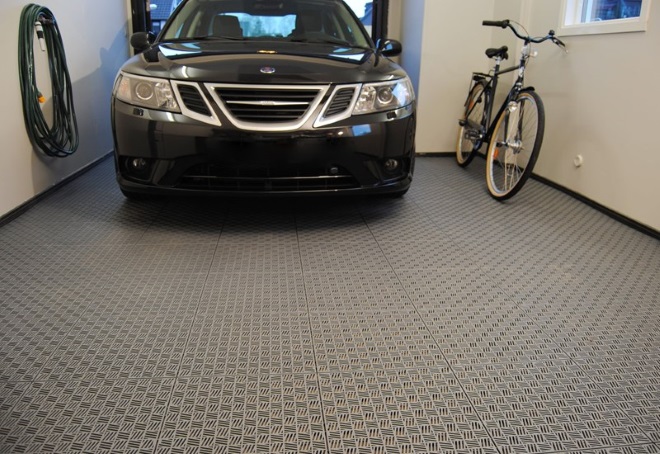Choosing floor tiles in the corridor: tips and photos
What to finish floor in the hallway? Linoleum? Not bad, but somehow too corny. Laminate flooring? It is possible, but great chance to damage the coating as a result of constant exposure to spray, dirt or even the claws of the dog. So maybe it's better to do bulk floor and never again return to this problem, because the bulk floor is almost an eternal cover? The option is not bad, but it is very expensive and complicated in terms of installation. They haven’t come up with anything more ideal than ceramic tiles. This is a durable, aesthetic and durable coating, the purchase and installation of which will not be a big problem. It remains only to figure out how to choose floor tiles in the corridor and what, in addition to appearance, it is extremely important to pay attention to the store.
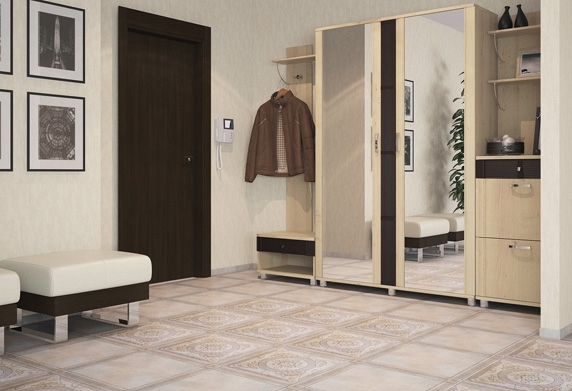
Pros and cons of ceramic tiles
In order not to be unfounded, claiming that ceramic tile is actually an ideal floor covering, we list The main advantages of this material:
- high strength. This figure, of course, depends on the class of the tile, but in general, the material perfectly tolerates mechanical damage, withstands significant loads and retains its original appearance for a long time;
- tile durability reaches 50 years, but such survivability should be counted on if the installation was carried out in accordance with all the rules;
- moisture resistance. Tiled spread the floor and walls in the bathroomso that those droplets of rainwater and melted snow that fall on the tile in the corridor, the material will definitely calmly transfer;
- fire resistance. The material, prepared on the basis of clay, quartz and other minerals, and calcined in the furnace acquires a record resistance to high temperatures;
- hygiene. It is very easy to wipe all kinds of contaminants from a tile, you can use almost the entire range of detergents, but for hallways and corridors this is important;
- environmental friendliness. The tiles are made on the basis of natural raw materials, so that the material can be considered completely safe for health;
- huge selection and aesthetics. Manufacturers offer tiles of different sizes, shapes, colors and textures. A huge assortment of floor tiles in the corridor can be found on the website of the KERAMOGRANIT.RU store, which offers products of leading world brands. There is an option for every taste and budget;
- just restoration. If one or a couple of tiles suddenly crack, they can be replaced without dismantling the entire coating. Of course, this option will be possible if you were prudent even at the time of purchase and purchased a little more tile than was required;
- relative ease of installation. It is more difficult to lay the tile than, for example, linoleum, but you can still do it yourself, which cannot be said about bulk floors.

Disadvantages quality tiles have a bit. This is fragility (if you drop something heavy, that is, there is a risk that the material will crack) and a cold surface. The last minus is not so significant for the corridor, but you can fix the situation by installing underfloor heating systems. The tile is slippery - such in the corridor, where it can be humid, there is no place, but we will talk about this separately. All other disadvantages are inherent in low-quality material.It can crack during installation and for the first time after it, lose color, have a geometry that is not very accurate.
Ceramic Tiles, Porcelain Tiles and Quartz Vinyl Tiles
Tiles that are well-known to us are often confused with similar coatings, namely:
- porcelain tile, which is based on several types of clay with the addition of granite, feldspar or quartz. As a result, a material comes out that, in terms of strength and wear resistance, is practically not inferior to natural stone. Porcelain tile is unlikely to break even when a heavy object falls, but it is not cheap, and many experts believe that it is too durable for an ordinary residential apartment;

- quartz vinyl tile somewhat reminiscent of ordinary tiles, but in the manufacturing process plasticizers, stabilizers and pigments are added to the quartz sand. The basis, however, is still quartz, which gives manufacturers the basis to declare the naturalness and harmlessness of the material. Polymer additives make the coating more flexible and resistant to impacts. In principle, this is a very good option for the corridor, but the range of such tiles is much more modest than tile;

- Golden tile became a real bestseller in South Korea and begins to conquer the domestic market. This is a multi-layer coating. At the bottom is compacted PVC, then comes a layer of crushed stone mixed with resin, then fiberglass and a film with a pattern. The principle is similar to a laminate, but the result is a more durable and reliable coating that can mimic any kind of stone or wood.

Ceramic tile strength
Corridor - a place with increased traffic. Heels, dirty shoes, all kinds of loads from stores are not uncommon here, so the tiles should be so resistant that they withstand such a load every day and keep their original appearance. To understand how resistant the product is to you, just look at strength class. There are five of them, and on the packaging you can see the abbreviation PEI followed by a number:
- class 1 and 2 - this is a tile that is suitable for rooms with a small load, as well as for those where they walk barefoot or in slippers (bathroom, for example);
- 3-4 grade more resistant to damage, designed for frequent cleaning and walking in shoes. Such a tile is great for corridors, but many experts are sure that it is better to take class 4 material;
- 5th grade - This is a tile of maximum strength, this is usually used for flooring in factories, in offices, shops, restaurants and other rooms with high traffic. Such material is not suitable for the corridor for the simple reason that it is too durable (read - expensive), and the variety of patterns leaves much to be desired.

Moisture resistance of ceramic tiles
High temperature firing tiles allow you to achieve minimum indicators of water absorption of the material. Even the simplest tiles are not afraid of moisture, but different types of tiles differ significantly in their ability to absorb moisture. If a material with water absorption of about 6% is suitable for cladding residential premises, then for a corridor it is better to take a tile with an indicator of 3%.
Coefficient of friction
When the tile gets wet, it becomes slippery. In the corridor, it will often be necessary to wash it, and if you add here a high risk of dropping dirt, rain and melted snow from the street, it turns out to be completely traumatic. To reduce the risk of a possible fall, it is better to take a matte tile, and even better - with a noticeable embossed pattern. On such a surface, even if it is wet, it is difficult to slip.
In the marking you can find such an indicator as the coefficient of friction. For a normal non-slip tile he must be at least 0.75. Material with a coefficient of 0.3-0.4 is too slippery for the corridor. However, it is also undesirable to take too embossed tiles, otherwise you may be tormented to clean all cavities and irregularities from dirt.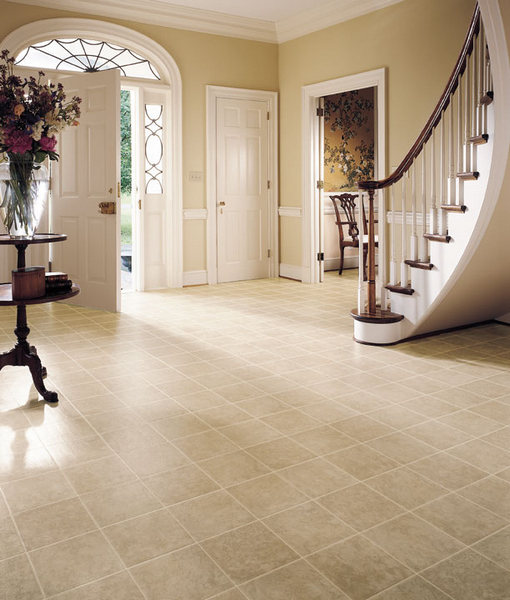
Chemical resistance
In principle, ceramic tile is a fairly inert material, but tile is different. On the packaging you can find an indicator of resistance to chemicals, which is expressed literally from D (minimum resistance) to AA (maximum resistance). You will have to wash the tiles in the corridor more often, and in order not to bother yourself with the selection of specific detergents, it is better to take a tile of class A or AA. In extreme cases, class B tiles will do.
Hardness and grade
The hardness of the tiles is determined by the school of Mohs. It is clear that a significant load will be carried out in the hallway on the tile, but still it is not as great as, for example, in production, so you can get by with tiles with average indicators - 6-7 points.
The whole tile is divided into three classes: the first class is marked in red, the second in blue, the third in green. Of course, it is better to take first class tiles. Yes, it costs more, but at the same time, the share of defective products in this category does not exceed 5%, and for third-class tiles this figure can reach 25%.
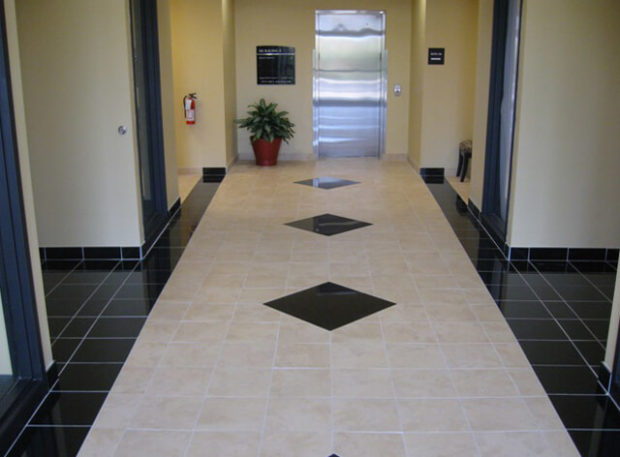
Ceramic tile size
The variety of tile formats is not as huge as the range of colors and textures, but also quite decent. Tiles are produced in a format from 10 * 10 cm to 70 * 120 cm, there are square and rectangular tiles, as well as tiles of a non-standard shape. When choosing, first of all, start from your own preferences and design project, but do not forget to also take into account some purely practical recommendations:
- large tiles look good only in spacious rooms, a corridors are often not large in size, so it is best to stay on the most popular format - 30 * 30 cm;
- previously does not interfere with measuring the dimensions of the corridor and figure out the layout of the tiles, and then choose the tile when laying which will be the least waste. It may be that tiles 40 * 40 cm in size will be able to be laid without cutting at all, and 30 * 30 cm will have to be cut. The choice is obvious;
- the smaller the tile, the more tile joints, and it’s much more difficult to clean them than the tile itself, so it is better not to use too small tiles;
- in the store, pay attention to the foot icon on the tile package. It shows that the tile is floor.

Color and texture of tiles
That's where the real freedom for imagination! The tiles are produced in different colors, plain and with patterns, with imitation of stone and wood - to find the one that will captivate you at first glance, it is not difficult. Rely on your own preferences and the general style of the corridor, but do not forget to take into account some of the recommendations of the designers:
- give preference to light shadessince they are able to visually make the corridor larger. If you are a happy owner of a spacious hallway, then you can act within whole color gamut;
- black and white tiles are easily soiled. Contamination will be less noticeable on gray, beige and brown tiles, on a matte surface all scratches and debris are much less noticeable, as on a tile with a pattern;
- tile imitating wood will be appropriate in the interior in style provence, classic and country;
- tile imitating natural stone also fits perfectly into the rustic interior;
- the presence of patterns depends only on the style of the interior. For minimalism hi-tech, loft It is better to use a plain tile. Tile with patterns is more suitable for classic and ethnic interiors, and the nature of the pattern will depend on the specific direction of design;

Wood tile
- To make the interior a little more fun and interesting, you can use tiles of the same format, but in different colors or with a different pattern, but here it is very important not to slide into bad taste. You can try to combine large tiles with smaller ones, getting an interesting ornament.Many tile collections have decorative inserts, thanks to which you can collect the original coating;
- It is desirable that the floor in the corridor does not come off the floor in adjacent rooms. You can build a combination in contrast or in an adjacent shade;
- You can lay out tiles as you like. In addition to the classic strict order, you can use herringbone masonry when it comes to tiles with imitation wood. You can lay out tiles with a shift, you can lay out the central part of the corridor in a distinctive way, and diagonal laying of tiles is a classic of the genre when you need to visually make the room a little bigger.

Is it possible to combine coverage in the corridor?
Not only possible, but necessary! With the help of this technique, it will be possible to identify several zones, for example, to clearly fence off the area where shoes should be removed, or simply to add some variety to the interior.
You can combine different types of tiles, as well as combine tiles with other materials. The most popular option is laying tiles around front door and the use of parquet / laminate in an area away from it. Some sections can be raised or lowered relative to the level of the rest of the floor, but making swings of more than 3 cm is undesirable. The border can be either straight or arched. When combining materials, do not forget about color combination.
For long narrow corridors the presence of two zones becomes a necessity. This way you can break the geometry and turn the rectangle into two squares.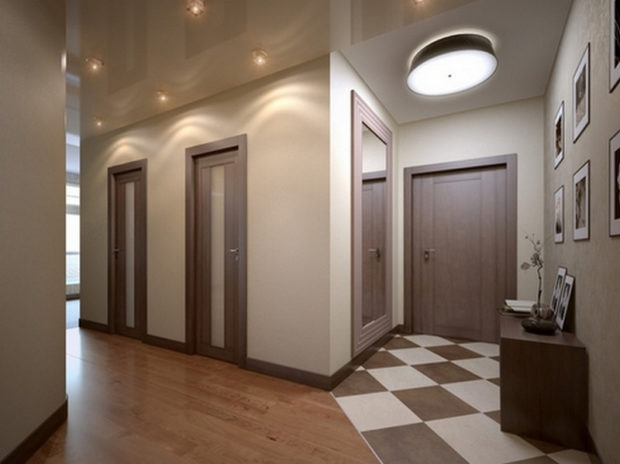
How to lay a tile?
We dedicated the tile installation process whole article, so it’s pointless to dwell on this issue in detail. We only note basic principles of laying ceramic tiles on the floor:
- the service life depends on how correctly and faithfully the tile was laid;
- the main floor must be properly aligned, for this use special compounds, and the alignment result is evaluated using level;
- apply a primer to a dry, even floor;
- You can start installation from one of the corners. If you need to make some kind of tile pattern, it is better to pre-mark and start laying with one of the central elements;
- after special adhesive composition ready, it is applied to the tile with a smooth spatula and leveled with a notched trowel. The glue is prepared according to the instructions on the package, but you should not do a large amount of it immediately;
- the solution is also better applied to the floor, and it is desirable that the direction of the grooves in the solution on the tile and on the floor is different;
- so that the distance between the tiles is the same, use special crosses that are removed after installation;
- the laid tile is adjusted in level by tapping with a rubber mallet;
- when the solution is completely dry, you can go to grouting.

What else?
There are a lot of tile manufacturers, it is better to read reviews about everyone and study their collections, but there are countries, where so strong traditions have been formed in the production of tiles that all the tiles produced there are considered to be of high quality. A vivid example is Italy, Spain and Portugal. Czech and Polish tiles are cheaper, but they are slightly worse in quality. There are good samples among domestic tiles.
To ensure that the tile joints remain clean for a long time, they are recommended to be treated with paraffin from time to time.

